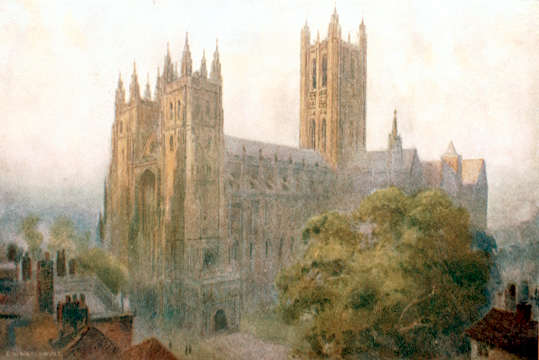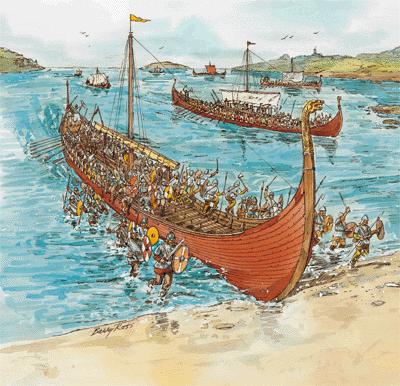Links and resources
Link to a map of Anglo-Saxon England
A BBC radio program, November 2004, on Bede; the link takes you to a BBC page
A BBC radio program, February 2003, on the Lindisfarne gospels
Christianity in Anglo-Saxon England, to 793
 1.
Augustine
of Canterbury (d. ca. 604). Sent by Pope Gregory I to England;
converted King Ethelbert in a few months; was made first archbishop of
Canterbury. See Bede’s biography of him. See also Bede’s
account of his correspondence with the Pope about such things as the adaptation
of Christian custom. Came into unhappy contact with British (Celtic)
bishops and laypeople. Took over some of their churches.
1.
Augustine
of Canterbury (d. ca. 604). Sent by Pope Gregory I to England;
converted King Ethelbert in a few months; was made first archbishop of
Canterbury. See Bede’s biography of him. See also Bede’s
account of his correspondence with the Pope about such things as the adaptation
of Christian custom. Came into unhappy contact with British (Celtic)
bishops and laypeople. Took over some of their churches.
2. Canons — those living the canonical life in community with the bishop in the cathedral.
3. Celtic missionaries. While Augustine and his Roman confrères were evangelizing pagan England from the south. Celtic missionaries were evangelizing it from the north:
- Aidan, d. 651, a monk of Iona, invited by King Oswald to evangelize his people; founded a monastery on the Holy Island of Lindisfarne, which became a mission headquarters
- Chad, d. 672, pupil of Aidan, tireless missionary, bishop of Lindisfarne.
- Cuthbert, d. 687, missionary, prior and then bishop of Lindisfarne. His remains were miraculously preserved. On the destruction of Lindisfarne by the Vikings, the monks relocated on several occasions, always carrying the body of Cuthbert with them, until it finally came to rest in its present burial place at Durham in 999.
- Hilda (see Bede)
- Caedmon (see
Bede)
A major theme of early Anglo-Saxon Christianity — and a major theme in Bede’s account of it — is the tension between Roman and Celtic uses. Bede’s account is that the Synod of Whitby (the later Danish name for Streanaeshalch) in 664 settled the issues in favour of the Roman use.
4. Unifying the Church of England. Theodore of Canterbury (d. 690), a Greek-speaker from Tarsus on the Asian coast of the Mediterranean, sought to unify English Christianity. Before Theodore, in addition to the major divisions between Celtic and Roman, there were also diverse uses and practices in each of the seven nations of England, and each king decided which missionaries to receive and whom to make bishop. Theodore moved to bring all into one ecclesiastical province under the archbishop of Canterbury (himself). The Council of Hertford, 672, was his most significant success in this respect.
5. Bede, one of the greatest scholars in the West in the early Middle Ages.
6. The origins of the parish system are a little obscure, but apparently it happened this way: missionaries lived in the various mission headquarters (monasteries, from which “minsters”), and went out to communities of the English to teach, preach, pastor, and lead worship. Beginning in the eighth century landowners were building churches for them on their estates. The priests began to stay over at these churches and to become more permanently connected with them. In the Church of England system of patronage, the heirs and successors of the landowners who built the original churches had the right to appoint the clergy (or they could sell their right of appointment).
Important events in England 793-1500
 1.
The Vikings. Vikings (from a Scandinavian word apparently
meaning “pirates”) began to raid the British isles in the late
700s — the Holy Island of Lindisfarne was ravaged in 793. They
continued to be a threat until about 1100. Sometimes a few stayed
seasonally and established base camps for their armies. Gradually
many settled, intermarried, and became Christian, and extended their territory
in England. Battles between Saxons and Danes recurred. Occasionally
there was a Danish king of England. They came to be called Normans
(people from the north, i.e., Scandinavia). (The drawing comes from
a webpage with further
information about the Vikings.)
1.
The Vikings. Vikings (from a Scandinavian word apparently
meaning “pirates”) began to raid the British isles in the late
700s — the Holy Island of Lindisfarne was ravaged in 793. They
continued to be a threat until about 1100. Sometimes a few stayed
seasonally and established base camps for their armies. Gradually
many settled, intermarried, and became Christian, and extended their territory
in England. Battles between Saxons and Danes recurred. Occasionally
there was a Danish king of England. They came to be called Normans
(people from the north, i.e., Scandinavia). (The drawing comes from
a webpage with further
information about the Vikings.)
2. The Norman invasion. One group of Normans had a kingdom in Normandy, in present-day France, where they adopted the French language. The duke of Normandy, William, who had established a claim on the throne of England, led an army which conquered England between 1066 and 1070. (He had the Pope’s blessing for this.)
Christianity in England, 793-1066
1. Diocesan reorganization proceeds in the tenth century. Tensions between Christian and pagan continue to be seen. The disruption of church life by Danish incursions is clear.
2. A monastic
revival on Benedictine lines appears in the tenth century, partly
by way of reaction to the canonical communities. Dunstan, d. 988,
later archbishop of Canterbury; Aethelwold, d. 984; and Oswald, d. 992,
are significant. The ‘regularis concordia’, ca. 970, represents
their ideals.